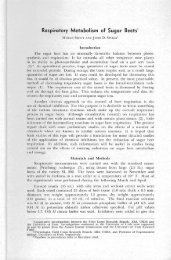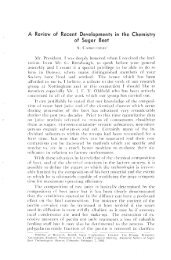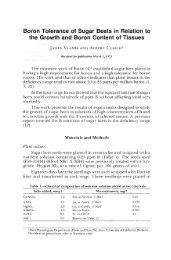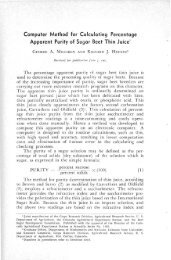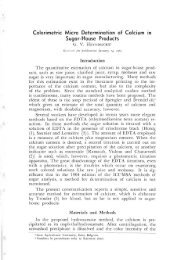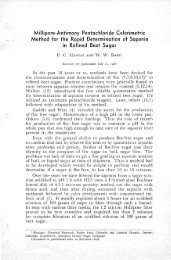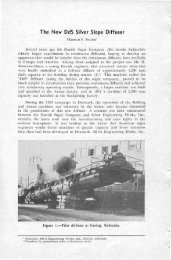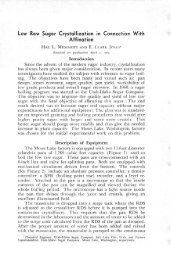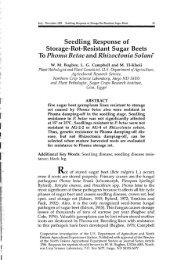Journal of Sugar Beet Research - Vol
Journal of Sugar Beet Research - Vol
Journal of Sugar Beet Research - Vol
Create successful ePaper yourself
Turn your PDF publications into a flip-book with our unique Google optimized e-Paper software.
4 <strong>Journal</strong> <strong>of</strong> <strong>Sugar</strong> <strong>Beet</strong> <strong>Research</strong> <strong>Vol</strong>. 45 Nos. 1 & 2<br />
steel spatula onto several flat 30.48 by 60.96 centimeter plastic trays and<br />
placed into a laminar flow hood (Environmental Air Control Inc., Model<br />
6467, Hagerstown, MD) overnight for air-drying. Fungicide coatings on<br />
the seeds necessitated treatment <strong>of</strong> the 2002 bacterial applications differently<br />
from 2001 applications. In 2002, 600 g <strong>of</strong> seed to be treated with<br />
bacteria were distributed in a tray, leveled by hand, and placed inside<br />
<strong>of</strong> a fume hood (Model PL-301, Two Rivers, WI) to aid in air-drying.<br />
Bacterial suspensions in nutrient broth were sequentially applied (~5<br />
ml per application) to each <strong>of</strong> the three seed variables (Table 1) at 30<br />
min time intervals utilizing an air-powered liquid atomizer (Model #15,<br />
Devilbiss, Somerset, PA) pressurized to 8.28 Pa 4 . Seed was allowed to<br />
dry in between applications in an effort to retain the chemical fungicide<br />
coatings. A total <strong>of</strong> 10 applications were made amounting to 50 ml <strong>of</strong><br />
applied bacterial suspension. Seed was dried overnight before packaging<br />
and was stored at 4°C for no longer than 20 days before planting.<br />
Resistance inducing compounds (RIs) were applied to 14 day-old<br />
seedlings 2 days prior to inoculation with A. cochlioides. Solutions<br />
<strong>of</strong> the RIs harpin (Messenger TM , Eden Biosciences, Bothell, WA),<br />
rib<strong>of</strong>lavin, and salicylic acid (SA) were prepared in distilled water at<br />
the concentrations <strong>of</strong> 40 µg/ml (a 10-fold concentrate with respect to<br />
the field application rate recommended by the manufacturer), 7 µg/ml<br />
(Aver’yanov et al., 2000), and 2.8 mg/ml (Rasmussen et al., 1991),<br />
respectively, to a final volume <strong>of</strong> 50 ml. The RIs were transferred to<br />
a pressurized tank sprayer (Stanley Model 7402, Chapin Mfg., Batavia<br />
NY) adjusted to 6.9 Pa 4 and applied at a rate <strong>of</strong> 0.5 ml/conetainer.<br />
Zoospores <strong>of</strong> A. cochlioides isolate 898A(IV) were produced by<br />
standard methods (Parke and Grau, 1992) and quantitated microscopically<br />
on a haemocytometer. Zoospore suspensions were applied to the<br />
conetainers in 5 ml aliquots resulting in seedling exposure to 30, 100,<br />
300, 1000, and 10,000 spores per treatment. Plants were maintained in<br />
a growth chamber (Conviron Model PGR15, Winnipeg, Manitoba) at 26<br />
degrees Centigrade under a 16 hr daylength until harvested for disease<br />
rating. The root rot index (RRI) described by Beale et al. (1994), calculated<br />
as<br />
Σ (Disease rating X number <strong>of</strong> plants with rating)<br />
RRI = ------------------------------------------------------------------- X 100<br />
(Total number <strong>of</strong> emerged seedlings X 3)<br />
was used to evaluate seedling damage at 6 days post-inoculation (dpi)<br />
using a rating scale <strong>of</strong> 0 = healthy root, 1 = light brown hypocotyl, water<br />
soaked, 2 = hypocotyl brown, moderate amount <strong>of</strong> constriction, and 3 =



